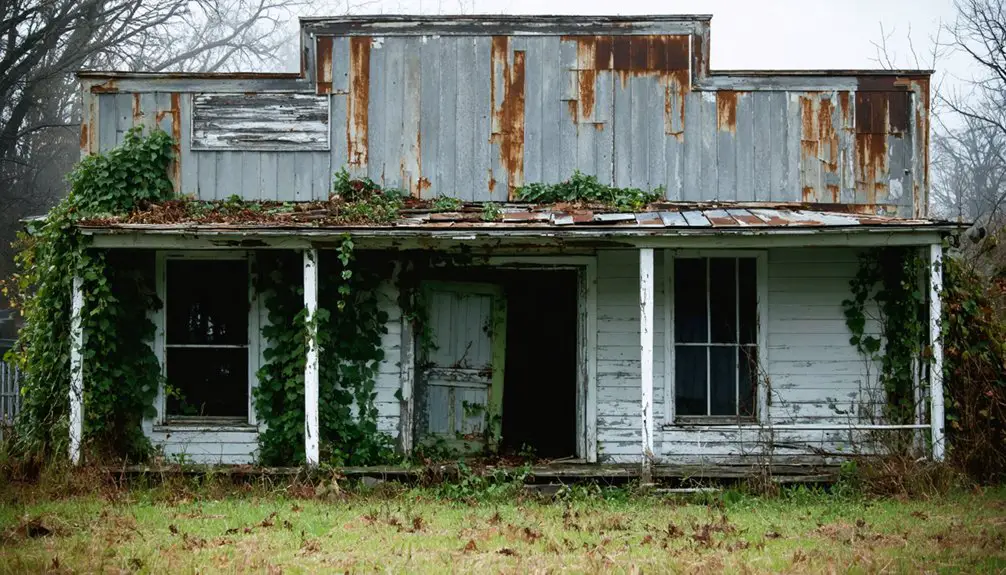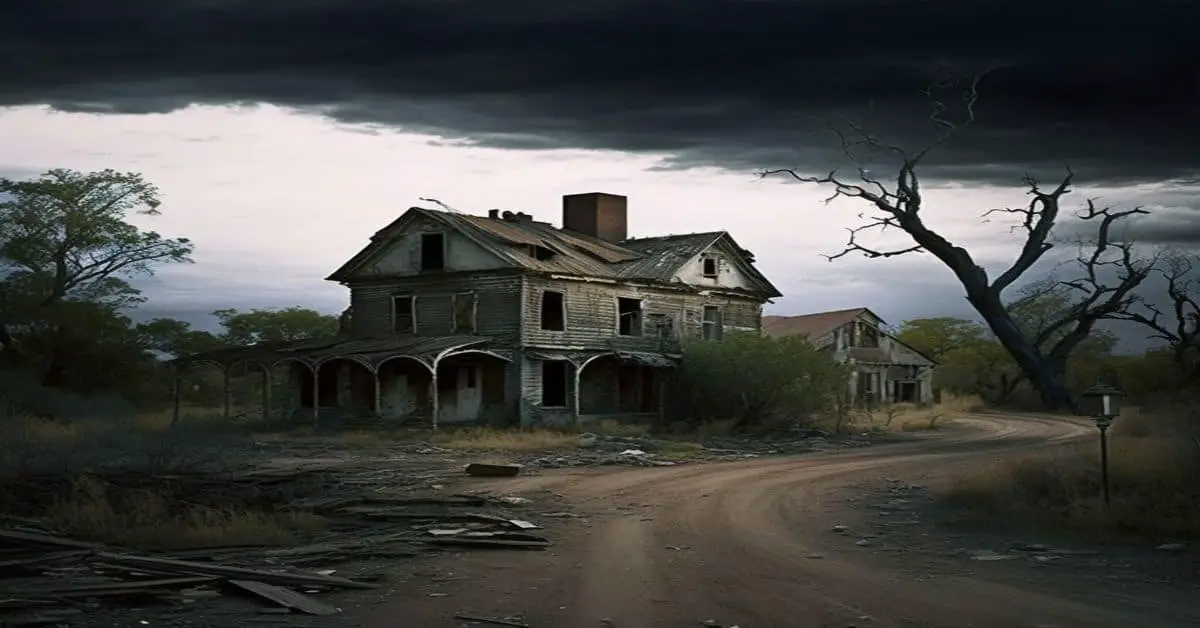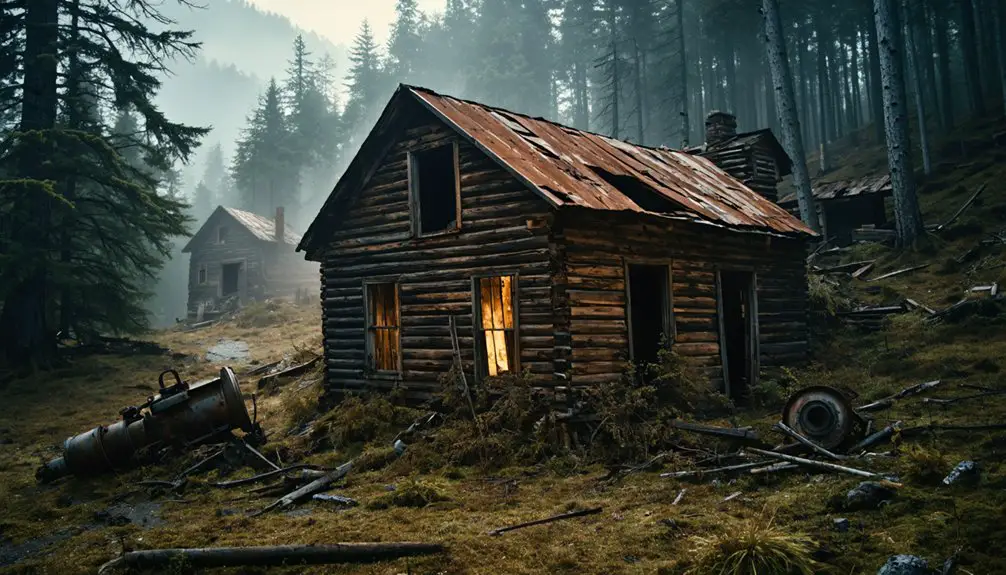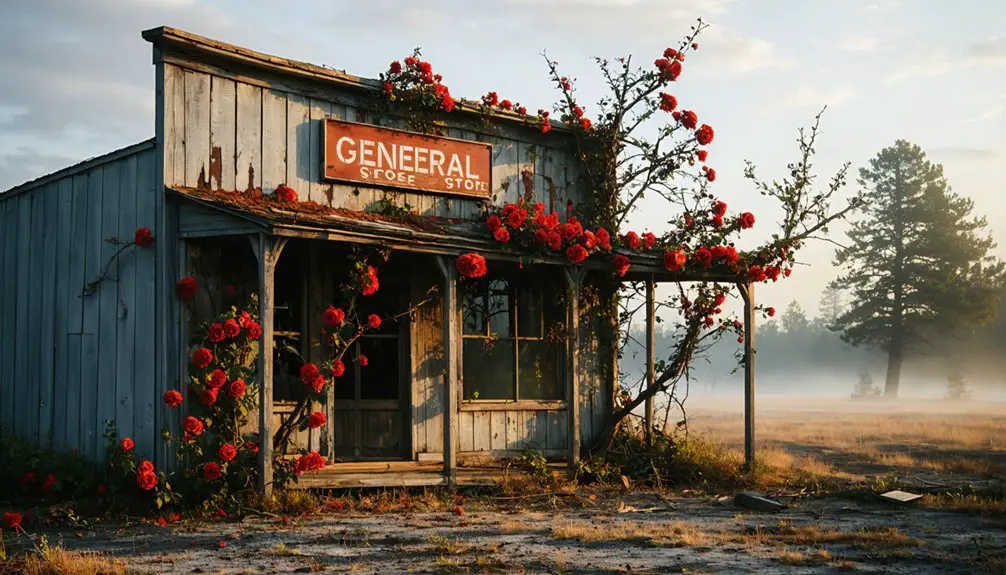You’ll find Vindex tucked away in western Maryland’s wooded hills, where concrete stairs and foundations are all that remain of this once-bustling coal mining town. From the late 1800s until 1950, it thrived as a company town built by the Johnstown Coal and Coke Company, complete with worker housing, a company store, and essential railway connections. Today, nature has reclaimed the streets where European immigrants once built their American dreams, though beneath the moss and vegetation, countless stories still echo through time.
Key Takeaways
- Vindex was a prosperous coal mining town in Maryland that became abandoned after mining operations ceased in 1950.
- Only concrete foundations and stairs remain today, with nature reclaiming the former streets and buildings of the town.
- The town featured company-provided housing, a company store, and essential facilities for miners and their families.
- European immigrants, primarily from Germany and Poland, formed the core workforce and community during the town’s peak.
- The Western Maryland Railway served as the town’s vital transportation link for coal shipments until its eventual decline.
Origins of a Coal Mining Settlement
While Vindex began as a lumber mill settlement, it quickly evolved into a thriving coal mining community upstream from Bloomington near Kitzmiller in Garrett County, Maryland.
You’ll find its economic shift was driven by the Johnstown Coal and Coke Company, which established extensive mining operations in the area. The town developed into a complete community with company store and housing, reflecting the typical amenities found in coal mining towns. The town’s strategic location and rich coal deposits made it an ideal site for development, demonstrating the community’s resilience as it changed from lumber to coal production.
The Johnstown Coal and Coke Company transformed Vindex from a lumber settlement into a thriving coal mining hub.
Today, only concrete stairs and foundations remain as evidence of this once-bustling mining town.
The settlement grew rapidly as the Western Maryland Railway extended its reach, with the Chaffee Branch’s switchback providing essential transportation infrastructure.
This railway connection allowed Vindex to efficiently ship its coal to regional markets, cementing its position as a significant contributor to Maryland’s coal industry until changing market conditions after World War II led to its decline.
Life in the Company Town
As workers streamed into Vindex during its peak years, they encountered a company town where every aspect of daily life fell under mining company control.
You’d find your home, school, church, and shopping all provided by the company, creating complex company dynamics that shaped everyday existence.
You couldn’t escape the company’s reach – they owned the store where you’d buy necessities, often on credit or with scrip they issued.
Despite these constraints, community resilience emerged through shared experiences. You’d gather with neighbors at church functions or school events, finding ways to build connections within the controlled environment.
Life revolved around mining schedules, with the Western Maryland Railway’s Shay locomotive marking time as it transported coal from the mines that dominated both landscape and livelihood.
The Johnstown Coal and Coke company’s influence extended throughout the region, employing hundreds in its extensive mining operations.
Today, only isolated concrete steps remain as a silent reminder of the once-bustling company store that served as the town’s commercial hub.
European Immigrant Heritage
When European immigrants arrived in Vindex during the late 1800s and early 1900s, they brought with them a rich tapestry of cultures that would shape the mining town’s character.
Like many Maryland communities, Vindex drew workers from various European backgrounds, particularly Germans, Poles, and other Eastern Europeans who’d entered through Baltimore’s bustling port – the second largest immigrant gateway after Ellis Island.
The German Society of Maryland provided crucial assistance to newly arrived immigrants, helping them establish roots in industrial towns like Vindex.
You’ll find that cultural integration in Vindex mirrored broader patterns across Maryland’s industrial towns, where immigrant laborers powered the mining operations while maintaining their ethnic traditions. Polish settlement in Maryland became particularly notable during the Civil War period.
The immigrant legacy lived on through their work ethic, religious practices, and social bonds, contributing to the town’s unique identity.
These newcomers found support through ethnic societies and mutual aid organizations that helped them adapt to life in their adopted homeland.
Mining Operations and Railway Systems
Because Vindex’s survival depended on coal extraction, the town’s mining operations and railway systems formed an intricate partnership that defined daily life from the early to mid-20th century.
You’ll find that bituminous coal mining technology dominated the local economy until 1950, with both surface and underground operations employing European immigrants and locals alike.
Similar to other mining towns, operations were unstable, as evidenced by the Wolf Den Coal Corporation that operated only 48 days across 1948 and 1949.
The Western Maryland Railway served as the town’s lifeline, using specialized Shay locomotives to navigate the challenging Appalachian terrain.
The rail transport infrastructure included strategic sidings and switchbacks, connecting Vindex to major distribution points along the Potomac watershed.
Vindex Energy Corporation operated the primary mining facility in the area, contributing significantly to Garrett County’s coal production.
You can still trace the abandoned railroad beds through the area, though they’re now mostly hidden by vegetation.
The mining company controlled everything from housing to the company store, creating a self-contained community that thrived until post-World War II economic changes led to its abandonment.
Daily Life Among the Coal Dust
You’d find daily life in Vindex revolved around the company store, where mining families gathered to purchase goods on credit and exchange news of the community.
The diverse immigrant population from Lithuania, Italy, and Eastern Europe brought their cultural traditions to social gatherings at the churches and shared spaces, though coal dust from the nearby mines was an ever-present reality in these communal activities.
Your social status and work roles often aligned with your ethnic background, creating distinct social networks within the tight-knit mining community where families supported each other through the harsh realities of coal town life.
Coal Town Social Life
Despite the harsh realities of coal mining life, Vindex’s social fabric was woven from a rich tapestry of immigrant cultures and shared experiences.
You’d find Lithuanian, Italian, and Eastern European families living alongside Anglo-Saxon and German residents, all united by their connection to the mines.
Community gatherings centered around the company-built church, school, and clustered housing areas.
After long shifts in the mines, you’d see neighbors congregating for evening socials, sharing cultural traditions from their homelands while supporting each other through the challenges of coal town life.
The tight-knit community maintained strong ethnic ties through religious celebrations and festivals, creating a unique blend of old-world customs and new American mining culture.
Despite limited recreational facilities, residents found ways to preserve their heritage through informal gatherings and shared customs.
The Johnstown Coal and Coke Company operated the local store where residents would gather to shop and socialize.
The community thrived until coal operations ceased in 1950, marking the end of an era for these diverse families.
Company Store Culture
While coal dust permeated every aspect of Vindex life, the company store stood as the town’s commercial and social nucleus, where miners and their families navigated a complex system of credit, scrip, and controlled commerce.
You’d find the store serving multiple roles – post office, gathering spot, and lifeline for essential supplies. The company store dynamics reflected the harsh realities of mining life, stocking durable work gear and staples suited for labor-intensive days.
Your economic freedom was limited by the store’s monopoly, as your wages often came in company scrip, creating inescapable dependencies.
Yet the store also adapted to serve its immigrant community, offering familiar foods and goods that provided comfort amidst the coal dust’s constant presence. For isolated Vindex residents, it was both a blessing and a burden.
Mining Family Traditions
Life in Vindex revolved around the rhythms of coal mining, as immigrant families from Lithuania, Italy, and Eastern Europe merged their cultural traditions with those of Anglo-Saxon and German American miners.
You’d find these family rituals woven into the fabric of daily existence, creating a unique tapestry of shared experiences in the shadow of the mines.
- Churches served as cultural anchors, preserving homeland traditions while fostering community bonds
- Multi-ethnic neighborhoods maintained distinct customs while embracing shared mining community practices
- Family gatherings centered around religious festivals and cultural celebrations
- Women preserved heritage through traditional cooking and homemaking skills
- Children learned both their ancestral ways and new American customs
Despite the harsh realities of mining life, these cultural traditions provided stability and identity, helping families endure the challenges of their coal dust-covered world.
The Rise and Fall of Vindex
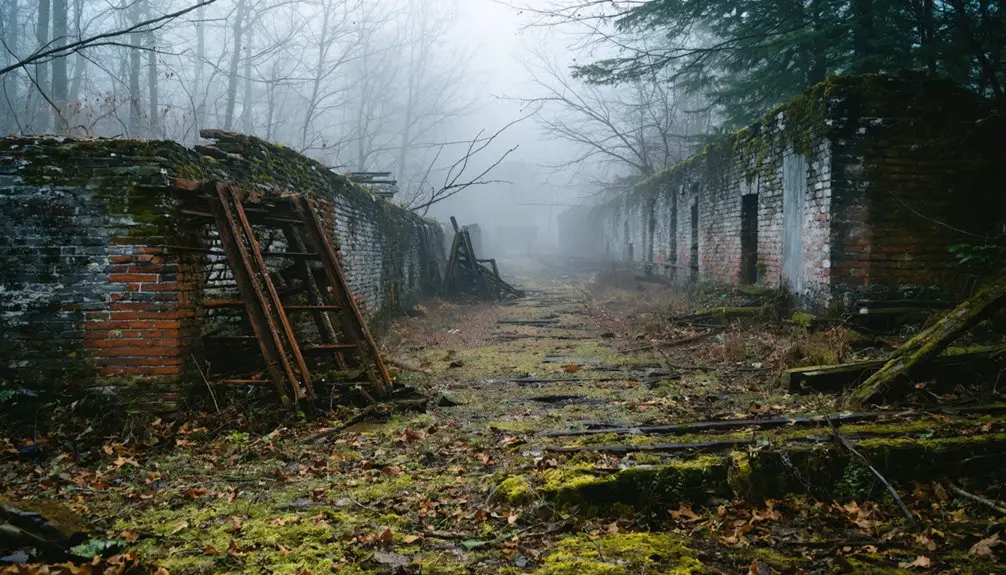
During the early twentieth century, Vindex emerged as a thriving coal mining town in Garrett County, Maryland, near the headwaters of the Potomac River.
You’d have found a diverse community of Lithuanian, Italian, and Eastern European immigrants working alongside Anglo-Saxon and German residents, all supporting their families through the mines.
The economic shifts of the mid-1900s proved devastating for Vindex. When coal operations ceased around 1950, you would’ve witnessed the cultural impact as families abandoned their homes, the company store closed its doors, and the Western Maryland Railway’s tracks fell silent.
Today, you’ll find only concrete steps, crumbling foundations, and overgrown railroad beds where a bustling community once stood. Vindex’s transformation from prosperous mining town to ghost town mirrors the broader story of Appalachian industrial decline.
What Remains Today
As nature steadily reclaims the former mining town of Vindex, you’ll find only scattered remnants of its industrial past beneath the encroaching vegetation.
The ruined foundations peek through thick undergrowth, while deteriorating chimneys stand as silent sentinels to the town’s coal mining heritage.
Archaeological surveys have revealed hidden features beneath the surface, painting a clearer picture of this abandoned community.
Today’s visitor can observe:
- Crumbling building foundations slowly disappearing into the earth
- Industrial remnants of the once-bustling mining operations
- Overgrown pastures where homes and businesses once stood
- Terrain scarred by coal extraction, including depressions and spoil piles
- Archaeological artifacts that challenge traditional coal town narratives
Without active preservation efforts, these traces of Vindex’s history continue to fade as nature advances its quiet conquest.
Stories From Former Residents
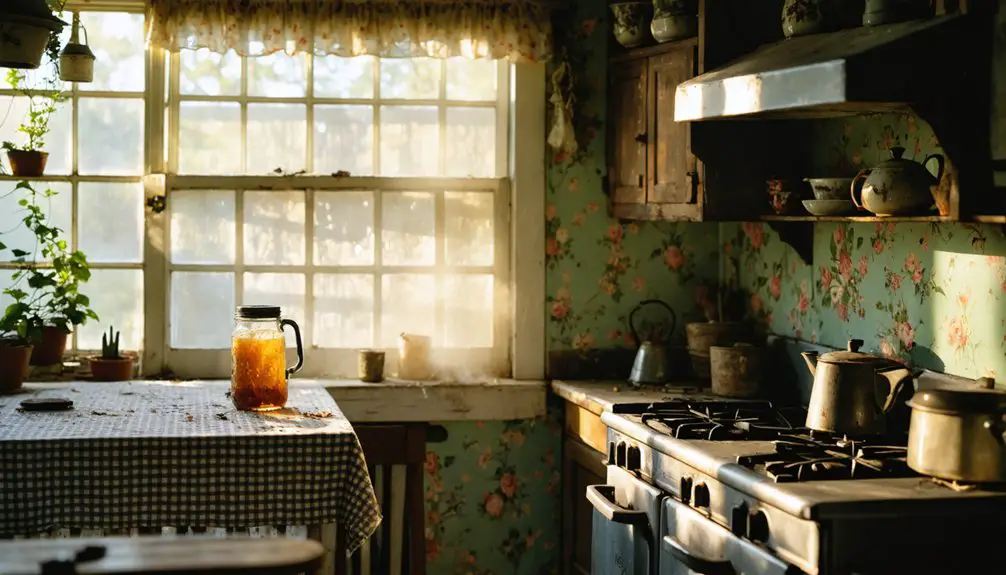
Through oral histories and documented accounts, former residents paint a vibrant picture of Vindex’s multicultural mining community in the early to mid-20th century.
Former residents’ stories reveal the diverse cultural tapestry of Vindex’s mining community during its bustling heyday.
You’ll hear tales of Lithuanian, Italian, and Eastern European immigrants working alongside Anglo-Saxon and German miners, their community memories preserved through stories of daily life centered around the company store and railroad.
Former miners recall a bustling town where labor struggles and cultural traditions blended in the close-knit community.
They’ll tell you about hundreds of residents sharing life in company-built housing, gathering at two churches, and relying on the central company store that doubled as their post office.
While few firsthand accounts remain today, those who lived through Vindex’s prime remember a thriving social hub that dissolved after the mines closed around 1950.
Natural Reclamation and Time’s Passage
Since the mines closed in 1950, nature has steadily reclaimed the once-bustling town of Vindex, leaving only scattered concrete foundations and moss-covered steps as evidence of its existence.
You’ll find thick vegetation covering the streets where miners once walked, and dense forest growth obscuring the sites of former homes and businesses.
- The concrete steps to the company store stand as silent sentinels of natural rebirth
- Native Appalachian flora has transformed mining corridors into wildlife habitats
- Memory preservation now relies on historical archives and aging photographs
- The Western Maryland Railway beds have dissolved into the forest floor
- Local historians document the remaining traces before they vanish completely
As time marches forward, you’ll witness nature’s increasing dominion over this ghost town, where the whispers of the past grow fainter beneath the rustling leaves of regenerating woodlands.
Preserving Maryland’s Coal Heritage
While nature steadily erases Vindex’s physical remnants, dedicated efforts to preserve Maryland’s rich coal mining heritage continue through extensive documentation and archival projects.
You’ll find the state’s mining legacy safeguarded through the digitization of nearly 500 historic mine maps, including precious records from the Maryland Bureau of Mines and Frostburg State University’s J.J. Rutledge Collection.
This meticulous coal mapping effort captures more than just geographical data – it preserves the stories of diverse immigrant communities who shaped Maryland’s mining towns.
From the Great Strike of 1882 to the rise of labor unions, these archives document the struggles and triumphs of miners from Austria, Poland, Hungary, and beyond.
Today, these preserved records serve both as essential planning tools and as windows into Maryland’s industrial past.
Frequently Asked Questions
What Was the Average Salary of a Coal Miner in Vindex?
You’ll find no exact salary records from Vindex’s coal mining era, though the economic impact varied based on daily wages, tonnage pay, and company store deductions common in Maryland’s early 1900s mining towns.
Are There Any Paranormal Activities Reported in the Abandoned Town Site?
You won’t find solid proof of paranormal activity in this old coal town. While YouTube explorers mention ghost sightings and haunted locations, there’s no well-documented evidence of supernatural occurrences here.
What Happened to the Displaced Residents After the Town’s Decline?
You’ll find most residents faced displacement challenges, moving to nearby towns like Kitzmiller or leaving Maryland entirely. They struggled with community reintegration while seeking new jobs beyond coal mining.
Can Visitors Legally Explore the Remaining Structures and Foundations Today?
While there aren’t posted “No Trespassing” signs, you’ll want to proceed cautiously as legal exploration guidelines remain unclear. Without explicit permission or restrictions, you’re exploring these unmanaged ruins at your own risk.
Were There Any Major Mining Accidents or Disasters in Vindex?
Yes, you’ll find several tragic Vindex accidents recorded, including miners killed by roof coal falls, loaded trip accidents, and crushing incidents. David Telford’s 1918 death from a coal fall stands out particularly.
References
- http://www.mountaindiscoveries.com/stories/fw2002/heritagetrail_plain.html
- https://en.wikipedia.org/wiki/Dodson
- https://wmwestsub.us/thomassub/vindex.htm
- https://www.historynewsnetwork.org/article/rousing-the-ghosts-of-appalachia
- https://rsftripreporter.net/ghost-towns-of-the-upper-potomac/
- http://www.wmrywesternlines.net/st_vindex.php
- https://thedailyrecord.com/2001/08/24/preservation-grant-fires-dreams-of-reviving-old-coal-town/
- https://mde.maryland.gov/programs/land/mining/documents/bureau of mines documents/annual reports/1924 b.o.m annual report.cv.pdf
- https://www.familysearch.org/en/wiki/Maryland_Cultural_Groups
- https://www.germanmarylanders.org/timeline-1
